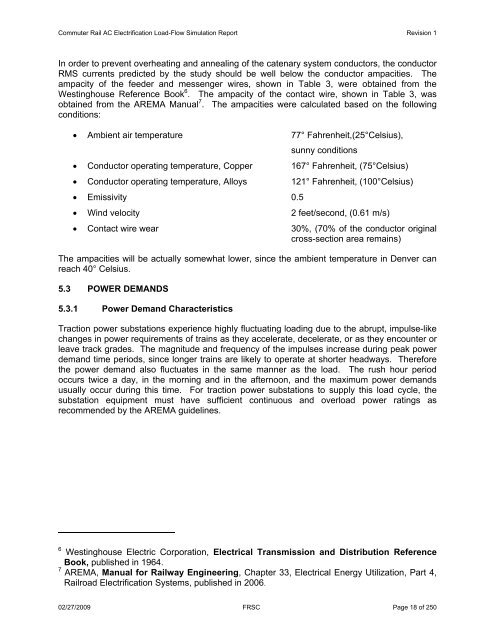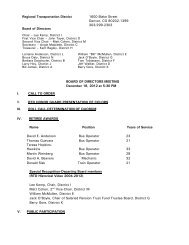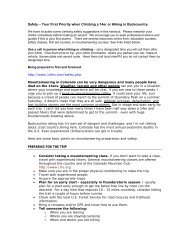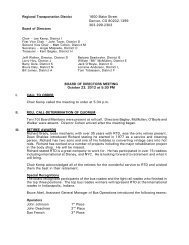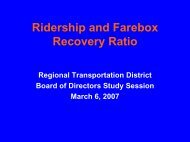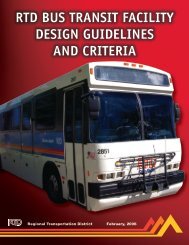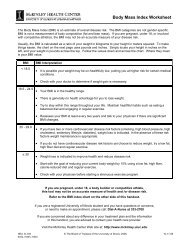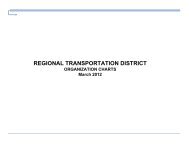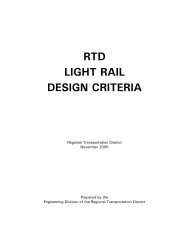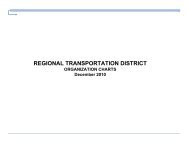Commuter Rail AC Electrification Load-Flow Simulation Report - RTD
Commuter Rail AC Electrification Load-Flow Simulation Report - RTD
Commuter Rail AC Electrification Load-Flow Simulation Report - RTD
Create successful ePaper yourself
Turn your PDF publications into a flip-book with our unique Google optimized e-Paper software.
<strong>Commuter</strong> <strong>Rail</strong> <strong>AC</strong> <strong>Electrification</strong> <strong>Load</strong>-<strong>Flow</strong> <strong>Simulation</strong> <strong>Report</strong> Revision 1<br />
In order to prevent overheating and annealing of the catenary system conductors, the conductor<br />
RMS currents predicted by the study should be well below the conductor ampacities. The<br />
ampacity of the feeder and messenger wires, shown in Table 3, were obtained from the<br />
Westinghouse Reference Book 6 . The ampacity of the contact wire, shown in Table 3, was<br />
obtained from the AREMA Manual 7 . The ampacities were calculated based on the following<br />
conditions:<br />
• Ambient air temperature 77° Fahrenheit,(25°Celsius),<br />
sunny conditions<br />
• Conductor operating temperature, Copper 167° Fahrenheit, (75°Celsius)<br />
• Conductor operating temperature, Alloys 121° Fahrenheit, (100°Celsius)<br />
• Emissivity 0.5<br />
• Wind velocity 2 feet/second, (0.61 m/s)<br />
• Contact wire wear 30%, (70% of the conductor original<br />
cross-section area remains)<br />
The ampacities will be actually somewhat lower, since the ambient temperature in Denver can<br />
reach 40° Celsius.<br />
5.3 POWER DEMANDS<br />
5.3.1 Power Demand Characteristics<br />
Traction power substations experience highly fluctuating loading due to the abrupt, impulse-like<br />
changes in power requirements of trains as they accelerate, decelerate, or as they encounter or<br />
leave track grades. The magnitude and frequency of the impulses increase during peak power<br />
demand time periods, since longer trains are likely to operate at shorter headways. Therefore<br />
the power demand also fluctuates in the same manner as the load. The rush hour period<br />
occurs twice a day, in the morning and in the afternoon, and the maximum power demands<br />
usually occur during this time. For traction power substations to supply this load cycle, the<br />
substation equipment must have sufficient continuous and overload power ratings as<br />
recommended by the AREMA guidelines.<br />
6 Westinghouse Electric Corporation, Electrical Transmission and Distribution Reference<br />
Book, published in 1964.<br />
7 AREMA, Manual for <strong>Rail</strong>way Engineering, Chapter 33, Electrical Energy Utilization, Part 4,<br />
<strong>Rail</strong>road <strong>Electrification</strong> Systems, published in 2006.<br />
02/27/2009 FRSC Page 18 of 250


